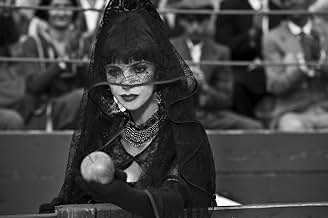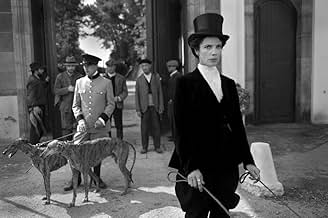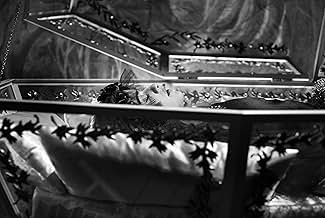IMDb-BEWERTUNG
7,5/10
11.971
IHRE BEWERTUNG
Ein neues Märchen über Schneewittchen mit dem Handlungsort in Sevilla und einer weiblichen Stierkämpferin als Protagonistin.Ein neues Märchen über Schneewittchen mit dem Handlungsort in Sevilla und einer weiblichen Stierkämpferin als Protagonistin.Ein neues Märchen über Schneewittchen mit dem Handlungsort in Sevilla und einer weiblichen Stierkämpferin als Protagonistin.
- Regie
- Drehbuch
- Hauptbesetzung
- Auszeichnungen
- 50 Gewinne & 55 Nominierungen insgesamt
Lito
- Gallo Pepe
- (as Lito y Tomás)
Tomás
- Gallo Pepe
- (as Lito y Tomás)
Empfohlene Bewertungen
Silent, black and white, expressionist, virtuoso in his classically vintage mise en scene, "Blancanieves" is a triumph of real cinema and invention, folk culture and Iberian poetry, a post-modern masterpiece in which the aesthetic of silent cinema – with its quotes and its expressive forms, the single power of pictures and musical score – it's not only an end, as it has been for the contemporary and more exalted "The Artist" (in which retro style was justified by the homage to old Hollywood), but a mean, a perfect mean, to tell a story: the usual one, by Grimm's brothers tiredly taken to screens so many times in so different ways, but here completely twisted, tipped over, in a Gothic, Spanish and extravagant version where Snow White and seven dwarfs are toreros, the set is Seville between '10s and '20s, and the usual Disney fable hearts and flowers go to hell in benefit of a dark tonality, a black humor and a grotesque taste which unchains an unstoppable series of stylistic, comical, poetic inventions, unpredictable as sensational. Under the aegis of a deep patriotic identity, "Blancanieves" has the rhythm of a corrida, the passion of a flamenco, the blood of the arena, the twists of circus and the weight of jealousy, of love duel, which is heart and root of Spanish romanticism. It's a modern "Carmen" with Oedipus complex, tuned with "guitara" and castanets, and painted with the oldest cinema aesthetic, close-ups, gags, depth of field, lights and darks of great silent cinema, here in its maximal expression, without any self-satisfaction at all. It's not a divertissement, and not a simple homage, not a pastiche: it's like a film should be, simple, dry, moving, as cinema in its beginning. Cinephile mannerism of Pablo Berger doesn't make lose the film in a style exercise, but helps to tell a black fairy tale, out of time, revolutionary and anarchic, which couldn't be represented some way else. A bond of immediate emotion and narrative synthesis, which discovers in the arena a theater of all life sensation range: laugh, crying, show, anguish, childhood lightness and horrid adults' cruelty, the weight of past and memories, ghosts and returns, a little antique world in which good and evil, hate and love, jealousy and solidarity, clash and overturn in front of an enraptured, manipulated audience who asks for more, who wants to be thrilled, who gets touched, who has fun, and in the end asks grace for the bull. And, on the very last scene, cries for masterpiece!
Blanca Nieves, or Snow White, is a variation on the old fable, with bullfighting being a major thematic difference. A great matador is seen praying in front of a statue of the Virgin Mary, as he awaits is battle with el toro. He enters to a worshippig crowd, which includes his pregnant wife cheering him on. Of course, things go horribly wrong and he ends up in a wheelchair and his better half has a difficult childbirth. A daughter is born and she winds up at an estate with a wicked stepmother, as in the original tale. This is all in black and white and it is also a silent film. I was reluctant to watch it, but once I got used to the placards used for dialogue, I was carried along by the story. Carmen, the little girl, grows up and circumstances bring her to a group of; you guessed it, seven bullfighters. They are little people, in keeping tradition with Grimm's book. I won't give away the ending, but I was thoroughly entertained by Blanca Nieves. The cinematography is beautiful and the acting excellent throughout. Be open minded, as far as watching a silent movie is concerned, and you will not be disappointed.
10sezme
I watched this film today at the Toronto International Film Festival. After many years of attending the festival, few if any films have made such an impact on me. Visually stunning, every scene shot in crisp black and white shouted out that colour is a mere distraction, a passing fad.
In a silent film, apart from the occasional inter-title, the visuals must tell the story, and in this case the filmmaker borrowed from the tropes of 1920s cinematic narrative, but added a more modern appreciation of human appetites and moralities. Much effort was made to reproduce the look and tone of classic silent film down to the 1.33:1 aspect ratio, but the current technologies used in production added an extra snap, crackle, and pop.
The story is Snow White, but set in the Seville of the 1920s: a girl, the daughter of a famous bullfighter, is raised by an evil stepmother. Instead of a mirror on the wall (though she has one of those, too) the stepmother relies on a fashion magazine to say who's the fairest of them all. A plot to kill the girl - now grown up - fails when she is rescued by a band of travelling bullfighting dwarfs who care for her until she's ready to fulfill her own destiny in the ring.
As befitting a fairy tale, the story is simple and direct, though there are shades of grey here and there in this black and white world of good and evil. But simple as it is, like the best children's stories, this one resonates at a deep level. And speaking of children, it can be debated whether any Grimm fairy tale is actually suitable for children. I would certainly not take a young child to see this one.
Have I mentioned the music? Anchoring the story to the setting, glorious Flamenco appears at key moments making the pulse quicken in time to the castanets.
Such a gorgeous film. I must see it again, if my heart can take it.
In a silent film, apart from the occasional inter-title, the visuals must tell the story, and in this case the filmmaker borrowed from the tropes of 1920s cinematic narrative, but added a more modern appreciation of human appetites and moralities. Much effort was made to reproduce the look and tone of classic silent film down to the 1.33:1 aspect ratio, but the current technologies used in production added an extra snap, crackle, and pop.
The story is Snow White, but set in the Seville of the 1920s: a girl, the daughter of a famous bullfighter, is raised by an evil stepmother. Instead of a mirror on the wall (though she has one of those, too) the stepmother relies on a fashion magazine to say who's the fairest of them all. A plot to kill the girl - now grown up - fails when she is rescued by a band of travelling bullfighting dwarfs who care for her until she's ready to fulfill her own destiny in the ring.
As befitting a fairy tale, the story is simple and direct, though there are shades of grey here and there in this black and white world of good and evil. But simple as it is, like the best children's stories, this one resonates at a deep level. And speaking of children, it can be debated whether any Grimm fairy tale is actually suitable for children. I would certainly not take a young child to see this one.
Have I mentioned the music? Anchoring the story to the setting, glorious Flamenco appears at key moments making the pulse quicken in time to the castanets.
Such a gorgeous film. I must see it again, if my heart can take it.
Although The Artist, the first Best Picture winner I've agreed with in a long time, took the mainstream by storm of its silent film renaissance style, Blancanieves is a similar revivial, if not as self-referential, and is on par with The Artist. Silent cinema in the modern age feels like it offers a brand new way of expressive cinema and Blancanieves is oozing with expression. With textured black and white shots and energetic editing, it's a rush of raw inspiration, making full use of the frame. With such a timeless story, there's a risk of it being a complete retread, but Blancanieves tells it in such a refreshing and unpredictable way in which I was constantly looking for the famous plot points and then pleasantly surprised me when it's revealed which character is playing what role. It's a film with such a warmth for the characters and builds their relationships in a great archetypal way. With its great pace, it hits story beats efficiently and I was never bored and always caught off guard with its reinventions, with the bullfighting angle implemented seamlessly. The highlight is the fantastic score, which also rivals The Artist, with its variety of styles, the best parts being when it has flamenco influences. Blancanieves is a very entertaining and tragic rendition of a great story that avoids sentimentality all the way. Although it winds down a little in the last third where it's run out of steam too much to develop the seven dwarfs fairly, its highs are still strong. One of the best the year has to offer and rivals Disney's own Snow White.
9/10
9/10
The professional reviews for this were so ecstatic that I may have been a bit over-hyped, and felt a twinge of disappointment in seeing it, which is not to say I didn't enjoy it
Entertaining and beautifully made, this is another modern black & while silent film, this one an adult re-telling of the Snow White myth. There's no denying the technical virtuosity on display, and the ways that film-maker Berger finds to update the tale to Spain in the 1920s, center the story around bullfighting, and still stay true to the original story are clever and sometimes very amusing.
What was missing for me was a deeper layer of emotion, I appreciated and respected the film, but it was too much a fairy tale for me to believe in it, yet too real for me to be carried away into a fantasy. That said, it's good enough that I will gladly re-visit it.
Entertaining and beautifully made, this is another modern black & while silent film, this one an adult re-telling of the Snow White myth. There's no denying the technical virtuosity on display, and the ways that film-maker Berger finds to update the tale to Spain in the 1920s, center the story around bullfighting, and still stay true to the original story are clever and sometimes very amusing.
What was missing for me was a deeper layer of emotion, I appreciated and respected the film, but it was too much a fairy tale for me to believe in it, yet too real for me to be carried away into a fantasy. That said, it's good enough that I will gladly re-visit it.
Wusstest du schon
- WissenswertesShot on color film stock and desaturated to black & white in post-production.
- PatzerAlle Einträge enthalten Spoiler
- Zitate
Antonio Villalta: [to Carmen de Triana] For you, and for our unborn child!
- VerbindungenFeatured in What Is Cinema? (2013)
- SoundtracksLa entrada
Written by Quintín Esquembre
Top-Auswahl
Melde dich zum Bewerten an und greife auf die Watchlist für personalisierte Empfehlungen zu.
- How long is Blancanieves?Powered by Alexa
Details
- Erscheinungsdatum
- Herkunftsländer
- Offizielle Standorte
- Sprachen
- Auch bekannt als
- Blancanieves
- Drehorte
- Sevilla, Sevilla, Andalucía, Spanien(general view)
- Produktionsfirmen
- Weitere beteiligte Unternehmen bei IMDbPro anzeigen
Box Office
- Bruttoertrag in den USA und Kanada
- 279.735 $
- Eröffnungswochenende in den USA und in Kanada
- 25.264 $
- 31. März 2013
- Weltweiter Bruttoertrag
- 2.585.522 $
- Laufzeit1 Stunde 44 Minuten
- Farbe
- Sound-Mix
Zu dieser Seite beitragen
Bearbeitung vorschlagen oder fehlenden Inhalt hinzufügen

![Tráiler [OV] ansehen](https://m.media-amazon.com/images/M/MV5BZDc5OTlhNjUtYzQ5Mi00NzAwLTg5MmUtYjdjNWQwNzgzN2FiXkEyXkFqcGdeQXRyYW5zY29kZS13b3JrZmxvdw@@._V1_QL75_UX500_CR0)






























